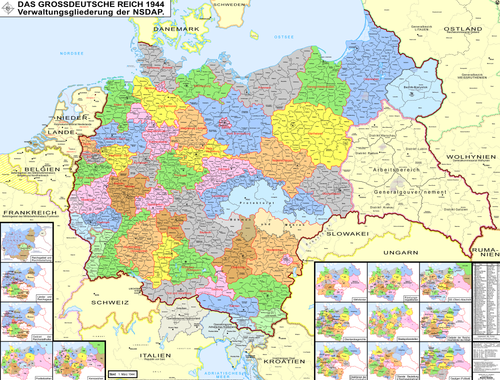| Final Designation | Headquarters | Years of Operation | Last permanent commander | Notes |
|---|
|
|
| Elbe | Dresden | November 16, 1933 – May 8, 1945 | SS-Gruppenführer
Ludolf von Alvensleben | Part of former SS-Gruppen Ost and Südost
Renamed Mitte June 1934 – April 1936.
Wehrkreis IV |
|
| Mitte | Braunschweig | November 16, 1933 – May 8, 1945 | SS-Obergruppenführer
Rudolf Querner | Part of former SS-Gruppe Nord.
Formed as Oberabschnitt Nordwest.
Renamed Mitte April 1, 1936.
Wehrkreis XI |
|
| Nord | Hamburg | November 16, 1933 – April 1, 1936 | SS-Obergruppenführer Werner Lorenz
| Part of former SS-Gruppe Nord.
Divided into SS-Oberabschnitte Nord (later Ostsee) and Nordwest (later Nordsee).
Wehrkreise II & X. |
|
| Spree | Berlin | November 16, 1933 – May 8, 1945 | SS-Obergruppenführer
Sepp Dietrich [notes 1] | Part of former SS-Gruppe Ost.
Formed as Oberabschnitt Ost. Renamed Spree November 14,1939.
Wehrkreis III |
|
| Süd | Munich | November 16, 1933 – April 20, 1945 | SS-Obergruppenführer
Karl von Eberstein | Part of former SS-Gruppe Süd.
Wehrkreis VII |
|
| Südost | Brieg;
Breslau | November 16, 1933 – May 8, 1945 | SS-Obergruppenführer
Richard Hildebrandt | Former SS-Gruppe Südost.
Wehrkreis VIII |
|
| Südwest | Stuttgart | November 16, 1933 – May 8, 1945 | SS-Gruppenführer
Otto Hofmann | Part of former SS-Gruppe Süd.
Wehrkreis V |
|
| West | Düsseldorf | November 16, 1933 – May 8, 1945 | SS-Gruppenführer
Karl Gutenberger | Part of former SS-Gruppe West.
Wehrkreis VI |
|
| Nordost | Königsberg | December 15, 1933 – May 8, 1945 | SS-Obergruppenführer
Hans-Adolf Prützmann [notes 2] | Part of former SS-Gruppe Ost.
Formed from a portion of Oberabschnitt Nord.
Wehrkreis I |
|
| Rhein | Koblenz | January 1, 1934 – September 11, 1943 | SS-Gruppenführer
Theodor Berkelmann | Part of former SS-Gruppe West.
Formed from a portion of Oberabschnitt West.
Merged with Westmark in September 1943 to form OberabschnittRhein-Westmark.
Wehrkreis XII |
|
| Donau | Vienna | February 15, 1934 – May 8, 1945 | SS-Gruppenführer
Walter Schimana | Formed as Oberabschnitt Österreich.
Renamed Donau May 1938.
Wehrkreis XVII |
|
| Main | Nuremberg | April 1, 1936 – May 8, 1945 | SS-Obergruppenführer
Benno Martin | Formed from a portion of Oberabschnitt Süd.
Wehrkreis XIII |
|
| Nordsee | Altona | April 1, 1936 – May 8, 1945 | SS-Gruppenführer
Georg-Henning Graf von Bassewitz-Behr |
Formed from division of the first Oberabschnitt Nord and named Nordwest.
Renamed Nordsee April 20, 1940.
Wehrkreis X |
|
| Ostsee | Stettin | April 1, 1936 – May 8, 1945 | SS-Gruppenführer
Emil Mazuw |
Formed from division of the first Oberabschnitt Nord and also named Nord.
Renamed Ostsee February 1, 1940.
Wehrkreis II |
|
| Fulda-Werra | Arolsen | January 1, 1937 – May 8, 1945 | SS-Obergruppenführer
Josias Erbprinz zu Waldeck-Pyrmont | Formed from portions of Oberabschnitte Rhein & Elbe.
Wehrkreis IX |
|
| Alpenland | Salzburg | June 1, 1939 – May 8, 1945 | SS-Obergruppenführer
Erwin Rösener [notes 3] | Formed from a portion of OberabschnittDonau.
Wehrkreis XVIII |
|
| Warthe | Posen | October 26, 1939 – May 8, 1945 | SS-Gruppenführer
Willy Schmelcher | Oberabschnitt in Wartheland .
Wehrkreis XXI |
|
| Weichsel | Danzig | November 9, 1939 – May 8, 1945 | SS-Gruppenführer
Fritz Katzmann | Oberabschnitt in Danzig-West Prussia .
Wehrkreis XX |
|
| Nord | Oslo | April 20, 1940 – May 8, 1945 | SS-Gruppenführer
Wilhelm Rediess | Oberabschnitt in Reichskommissariat Norwegen .
Third Oberabschittt named Nord. |
|
| Nordwest | The Hague | May 23, 1940 – May 8, 1945 | SS-Obergruppenführer
Hanns Albin Rauter | Oberabschnitt in Reichskommissariat Niederlande . |
|
| Westmark | Saarbrücken; Neustadt; Metz | August 1, 1940 – September 11, 1943 | SS-Gruppenführer
Theodor Berkelmann | Formed as Oberabschnitt Lothringen-Saarpfalz. Renamed Westmark October 15, 1941.
Merged with Rhein in September 1943 to form
OberabschnittRhein-Westmark.
Wehrkreis XII |
|
| Ostland | Riga | December 1, 1941 – March 3, 1945 | SS-Obergruppenführer
Friedrich Jeckeln | Oberabschnitt in Reichskommissariat Ostland . |
|
| Ukraina | Kiev | December 1, 1941 – April 20, 1944 | SS-Obergruppenführer
Hans-Adolf Prützmann | Oberabschnitt in Reichskommissariat Ukraine . |
|
| Ost | Krakau | September 15, 1942 – May 8, 1945 | SS-Obergruppenführer
Wilhelm Koppe | Oberabschnitt in the General Government. |
|
| Rhein-Westmark | Wiesbaden | September 11, 1943 – March 24, 1945 | SS-Gruppenführer
Jürgen Stroop | Formed by merger of
Oberabschnitte Rhein and Westmark.
Wehrkreis XII |
|
| Böhmen-Mähren | Prague | April 1, 1944 – May 8, 1945 | SS-Obergruppenführer
Karl Hermann Frank [notes 4] | Oberabschnitt in the Protectorate of Bohemia and Moravia. |
|
